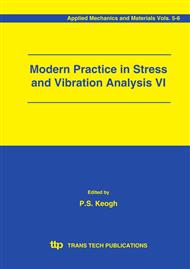[1]
D.F. Shi, F. Tsung and P.J. Unsworth: Adaptive time-frequency decomposition for transient vibration monitoring of rotating machinery, Mechanical Systems and Signal Processing, 2004, pp.127-141.
DOI: 10.1016/s0888-3270(03)00085-2
Google Scholar
[2]
D.L. Jones and T.W. Parks: A high resolution data-adaptive time-frequency representation, IEEE Transactions on Acoustics, Speech, and Signal Processing, Vol. 38, No. 12, Dec. (1990).
DOI: 10.1109/29.61539
Google Scholar
[3]
R.G. Baraniuk and D.L. Jones: A signal-dependent time-frequency representation: Optimal kernel design, IEEE Transactions on Signal Processing, Vol. 41, No. 4, April 1993, p.15891602.
DOI: 10.1109/78.212733
Google Scholar
[4]
D.L. Jones and R.G. Baraniuk: A simple scheme for adapting time-frequency representations, IEEE Transactions on Signal Processing, Vol. 42, No. 12, Dec. (1994).
DOI: 10.1109/78.340790
Google Scholar
[5]
Shie Qian and Dapang Chen: Joint time-frequency analysis, Prentice Hall, (1996).
Google Scholar
[6]
R.G. Baraniuk and D.L. Jones: A signal-dependent time-frequency representation: Fast Algorithm for Optimal kernel design, IEEE Transactions on Signal Processing, Vol. 42, No. 1, Jan. 1994, pp.134-146.
DOI: 10.1109/78.258128
Google Scholar
[7]
R.G. Baraniuk and D.L. Jones: A radial Gaussian signal-dependent time-frequency representation, IEEE International Conference on Acoustics, Speech, and Signal Processing, Toronto, 1991, pp.3181-3184.
DOI: 10.1109/icassp.1991.150131
Google Scholar
[8]
Mark J. Coates, Christophe Molina and William J. Fitzgerald: Regionally optimized kernels for time-frequency distributions, IEEE, (1998).
Google Scholar
[9]
R.G. Baraniuk and D.L. Jones: A signal-dependent time-frequency representation: Optimal kernel design, IEEE Transactions on Signal Processing, Vol. 41, No. 4, April 1993, p.15891602.
DOI: 10.1109/78.212733
Google Scholar
[10]
G. Illescas R: Vibration analysis for characterizing cracked shafts behaviour in operation, MSc Thesis, SEPI-ESIME, Instituto Politecnio Nacional (in Spanish, 2001).
Google Scholar


